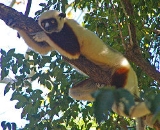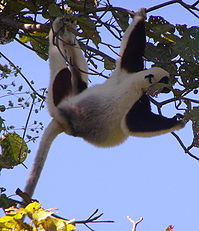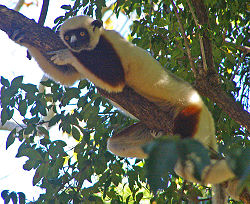
Coquerel's Sifaka
Encyclopedia
Coquerel's sifaka is a medium-sized lemur
of the sifaka
genus Propithecus. Like all lemurs, it is endemic to Madagascar
.
of northwestern Madagascar
, including coastal forests. It primarily occurs to the north and east of the Betsiboka River
, and the southerly portion of the range extends to Ambato-Boéni.
Groups of this species have a home range area amounting to 4-9 hectare
s. Overall densities in the wild are observed in the range of 60 individuals per km².
diet that varies by season. In the wet season
, it eats immature leaves, flowers, fruit, bark, and dead wood. In the dry season
, it eats mature leaves and buds. It may browse nearly 100 different plant species, but the majority of its feeding time will be concentrated on about 10% of these.
 Coquerel's Sifaka lives in matriarchal
Coquerel's Sifaka lives in matriarchal
groups of about three to ten individuals.
It is diurnal
and primarily arboreal. Much is known about its behavior from observations both in the wild and in captivity.
is rare in the animal kingdom as a whole but common among lemurs. A matriarchal system is particularly pronounced in Coquerel's sifaka. All adult and even most subadult females are dominant over males.
Females have preferential access to food and other resources. When a female is browsing a particular area or tree, a male must wait for her to finish before he moves there to feed himself. If he gets in the way of the female, she may lunge, smack at him, or bite him. The male then exhibits submissive behavior by rolling his tail between his legs, chattering softly, and baring his teeth in a grimace before quickly leaping out of her way.
When mating, Coquerel's sifaka commonly practices polyandry
. A female may choose to mate with only one male, but most often she will mate with several, from other visiting groups as well as from her own. Males compete for access to sexually receptive females. However, the winner of a fight will not necessarily be the one she selects to breed with. The criteria by which she chooses a mate are evidently more complex.
In some other animals, polyandrous mating is thought to raise the chances of successful fertilization, but this does not appear to be the case in Coquerel's sifaka. Instead, polyandry is thought to be advantageous because when paternity is confused, the likelihood of male infanticide
decreases.
 In the trees, Coquerel's sifaka moves by vertical clinging and leaping. It maintains an upright posture when at rest or when propelling itself between branches or trunks. This style of arboreal locomotion
In the trees, Coquerel's sifaka moves by vertical clinging and leaping. It maintains an upright posture when at rest or when propelling itself between branches or trunks. This style of arboreal locomotion
is characteristic of most, if not all, lemurs.
Occasionally Coquerel's sifaka will descend to the ground to cross open spaces. Its terrestrial locomotion is unique to its species. Like Verreaux's sifaka
, it moves in a series of bipedal hops with its arms thrown out to the sides for balance. However, whereas Verreaux's sifaka bounds sideways and crosses its legs one in front of the other, the Coquerel's sifaka bounds forward, like a kangaroo. It leans in the direction of its jump to achieve forward momentum.
All sifakas are known for their characteristic "shih-fak" alarm call. The first syllable is a low growl that "bubbles" in the throat, and the second is a clicking sound like an amplified hiccup. The "shih-fak" call is used to warn fellow group members of a potential ground predator or to threaten enemies and intruders. Coquerel's sifaka is highly territorial.
Contact calls used when groups are traveling include soft grunts and growls. If a sifaka is separated from its group members, it may emit a long, loud wail to find them.
One visual signal which Coquerel's sifaka uses to communicate is a rapid backward jerking of the head. This is a threatening action which may accompany the "shih-fak" call.
Sifakas also rely heavily on scent for communication. Males typically scent-mark using a gland in their throats, which they will rub back and forth along branches. Females are more likely to scent-mark with anogenital glands. It is not entirely clear what information is conveyed in these scents, beyond the demarcation of territory.
, habitat fragmentation
, and hunting pressure. In northwestern Madagascar, deforestation results from annual burning to create new pastureland for livestock. Trees are also cut for the production of charcoal.
Many local Malagasy
traditions prohibit hunting of the Coquerel's sifaka. However, these protective taboos are breaking down with cultural erosion and immigration
.
Even the protected areas in which the Coquerel's sifaka occurs offer it little protection. It is hunted even within Ankarafantsika, and the Bora Special Reserve has become seriously degraded.
(the eponymous PBS kids television program) is based on a Coquerel's sifaka.
Lemur
Lemurs are a clade of strepsirrhine primates endemic to the island of Madagascar. They are named after the lemures of Roman mythology due to the ghostly vocalizations, reflective eyes, and the nocturnal habits of some species...
of the sifaka
Sifaka
Sifakas are a genus of lemur from the family Indriidae within the order Primates. Their name of the family is an onomatopoeia of their characteristic "shi-fak" alarm call. Like all lemurs, they are found only on the island of Madagascar...
genus Propithecus. Like all lemurs, it is endemic to Madagascar
Madagascar
The Republic of Madagascar is an island country located in the Indian Ocean off the southeastern coast of Africa...
.
Description
Coquerel's sifaka is a vertical clinger and leaper with long, powerful hind legs and an upright posture. It has a head-body length of 42–50 cm and a tail length of 50–60 cm. The total mature length (including tail) is approximately 93 to 110 cm. Adult body mass is typically around 4 kg. The dorsal pelage and tail are white, with maroon patches on the chest and portions of the limbs. The coat is generally dense. Its face is bare and black except for a distinctive patch of white fur along the bridge of the nose. Its naked ears are also black, and its eyes are yellow or orange.Distribution
This species occurs only at altitudes of less than 300 ft in the dry deciduous forestsMadagascar dry deciduous forests
The Madagascar dry deciduous forests represent a tropical dry forest ecoregion generally situated in the western part of Madagascar. The area has high numbers of endemic plant and animal species but has suffered large-scale clearance for agriculture...
of northwestern Madagascar
Geography of Madagascar
Madagascar is an island in the Indian Ocean off the eastern coast of southern Africa, east of Mozambique. It is the fourth largest island in the world. The highest point is Maromokotro, in the Tsaratanana Massif region in the north of the island, at . The capital Antananarivo is in the Hauts...
, including coastal forests. It primarily occurs to the north and east of the Betsiboka River
Betsiboka River
Betsiboka River is a long river in central-north Madagascar. It flows northwestward and empties to Bombetoka Bay, forming a large delta. The river is distinct for its red-coloured water, which is caused by river sediments. The river carries an enormous amount of reddish-orange silt to the sea...
, and the southerly portion of the range extends to Ambato-Boéni.
Groups of this species have a home range area amounting to 4-9 hectare
Hectare
The hectare is a metric unit of area defined as 10,000 square metres , and primarily used in the measurement of land. In 1795, when the metric system was introduced, the are was defined as being 100 square metres and the hectare was thus 100 ares or 1/100 km2...
s. Overall densities in the wild are observed in the range of 60 individuals per km².
Diet
Coquerel's sifaka has an herbivorousHerbivore
Herbivores are organisms that are anatomically and physiologically adapted to eat plant-based foods. Herbivory is a form of consumption in which an organism principally eats autotrophs such as plants, algae and photosynthesizing bacteria. More generally, organisms that feed on autotrophs in...
diet that varies by season. In the wet season
Wet season
The the wet season, or rainy season, is the time of year, covering one or more months, when most of the average annual rainfall in a region occurs. The term green season is also sometimes used as a euphemism by tourist authorities. Areas with wet seasons are dispersed across portions of the...
, it eats immature leaves, flowers, fruit, bark, and dead wood. In the dry season
Dry season
The dry season is a term commonly used when describing the weather in the tropics. The weather in the tropics is dominated by the tropical rain belt, which oscillates from the northern to the southern tropics over the course of the year...
, it eats mature leaves and buds. It may browse nearly 100 different plant species, but the majority of its feeding time will be concentrated on about 10% of these.
Behaviour

Matriarchy
A matriarchy is a society in which females, especially mothers, have the central roles of political leadership and moral authority. It is also sometimes called a gynocratic or gynocentric society....
groups of about three to ten individuals.
It is diurnal
Diurnal animal
Diurnality is a plant or animal behavior characterized by activity during the day and sleeping at night.-In animals:Animals that are not diurnal might be nocturnal or crepuscular . Many animal species are diurnal, including many mammals, insects, reptiles and birds...
and primarily arboreal. Much is known about its behavior from observations both in the wild and in captivity.
Social Structure
MatriarchyMatriarchy
A matriarchy is a society in which females, especially mothers, have the central roles of political leadership and moral authority. It is also sometimes called a gynocratic or gynocentric society....
is rare in the animal kingdom as a whole but common among lemurs. A matriarchal system is particularly pronounced in Coquerel's sifaka. All adult and even most subadult females are dominant over males.
Females have preferential access to food and other resources. When a female is browsing a particular area or tree, a male must wait for her to finish before he moves there to feed himself. If he gets in the way of the female, she may lunge, smack at him, or bite him. The male then exhibits submissive behavior by rolling his tail between his legs, chattering softly, and baring his teeth in a grimace before quickly leaping out of her way.
When mating, Coquerel's sifaka commonly practices polyandry
Polyandry
Polyandry refers to a form of marriage in which a woman has two or more husbands at the same time. The form of polyandry in which a woman is married to two or more brothers is known as "fraternal polyandry", and it is believed by many anthropologists to be the most frequently encountered...
. A female may choose to mate with only one male, but most often she will mate with several, from other visiting groups as well as from her own. Males compete for access to sexually receptive females. However, the winner of a fight will not necessarily be the one she selects to breed with. The criteria by which she chooses a mate are evidently more complex.
In some other animals, polyandrous mating is thought to raise the chances of successful fertilization, but this does not appear to be the case in Coquerel's sifaka. Instead, polyandry is thought to be advantageous because when paternity is confused, the likelihood of male infanticide
Infanticide
Infanticide or infant homicide is the killing of a human infant. Neonaticide, a killing within 24 hours of a baby's birth, is most commonly done by the mother.In many past societies, certain forms of infanticide were considered permissible...
decreases.
Reproduction
Coquerel's sifaka mates between January and March. Infants are born in June and July after a gestation period of about 162 days. An infant will cling to its mother's chest until about a month or so after birth, then transfer to her back. Infants are weaned and become fully independent by about six months of age. Adult size is reached in one year.Locomotion

Arboreal locomotion
Arboreal locomotion is the locomotion of animals in trees. In every habitat in which trees are present, animals have evolved to move in them. Some animals may only scale trees occasionally, while others are exclusively arboreal. These habitats pose numerous mechanical challenges to animals...
is characteristic of most, if not all, lemurs.
Occasionally Coquerel's sifaka will descend to the ground to cross open spaces. Its terrestrial locomotion is unique to its species. Like Verreaux's sifaka
Verreaux's Sifaka
Verreaux's sifaka , or white sifaka, is a medium sized primate in one of the lemur families, Indriidae. It lives in Madagascar and can be found in a variety of habitats from rainforest to western Madagascar dry deciduous forests and dry and spiny forests...
, it moves in a series of bipedal hops with its arms thrown out to the sides for balance. However, whereas Verreaux's sifaka bounds sideways and crosses its legs one in front of the other, the Coquerel's sifaka bounds forward, like a kangaroo. It leans in the direction of its jump to achieve forward momentum.
Communication
Coquerel's sifaka uses a variety of auditory, visual, and olfactory signals to communicate.All sifakas are known for their characteristic "shih-fak" alarm call. The first syllable is a low growl that "bubbles" in the throat, and the second is a clicking sound like an amplified hiccup. The "shih-fak" call is used to warn fellow group members of a potential ground predator or to threaten enemies and intruders. Coquerel's sifaka is highly territorial.
Contact calls used when groups are traveling include soft grunts and growls. If a sifaka is separated from its group members, it may emit a long, loud wail to find them.
One visual signal which Coquerel's sifaka uses to communicate is a rapid backward jerking of the head. This is a threatening action which may accompany the "shih-fak" call.
Sifakas also rely heavily on scent for communication. Males typically scent-mark using a gland in their throats, which they will rub back and forth along branches. Females are more likely to scent-mark with anogenital glands. It is not entirely clear what information is conveyed in these scents, beyond the demarcation of territory.
Conservation status and threats
Though its populations are thought to be widely distributed, Coquerel's sifaka is found in only two protected areas in Madagascar: the Ankarafantsika National Park and the Bora Special Reserve. It is an endangered species. The principal threats to its existence are deforestationDeforestation
Deforestation is the removal of a forest or stand of trees where the land is thereafter converted to a nonforest use. Examples of deforestation include conversion of forestland to farms, ranches, or urban use....
, habitat fragmentation
Habitat fragmentation
Habitat fragmentation as the name implies, describes the emergence of discontinuities in an organism's preferred environment , causing population fragmentation...
, and hunting pressure. In northwestern Madagascar, deforestation results from annual burning to create new pastureland for livestock. Trees are also cut for the production of charcoal.
Many local Malagasy
Malagasy people
The Malagasy ethnic group forms nearly the entire population of Madagascar. They are divided into two subgroups: the "Highlander" Merina, Sihanaka and Betsileo of the central plateau around Antananarivo, Alaotra and Fianarantsoa, and the côtiers elsewhere in the country. This division has its...
traditions prohibit hunting of the Coquerel's sifaka. However, these protective taboos are breaking down with cultural erosion and immigration
Immigration
Immigration is the act of foreigners passing or coming into a country for the purpose of permanent residence...
.
Even the protected areas in which the Coquerel's sifaka occurs offer it little protection. It is hunted even within Ankarafantsika, and the Bora Special Reserve has become seriously degraded.
Cultural references
The lemur upon whom ZoboomafooZoboomafoo
Zoboomafoo is an American children's television series that aired from January 25, 1998, to April 21, 2001, and is still shown today in syndication depending on the area, and it is regularly shown on PBS Kids Sprout. A total of 65 episodes were aired...
(the eponymous PBS kids television program) is based on a Coquerel's sifaka.

